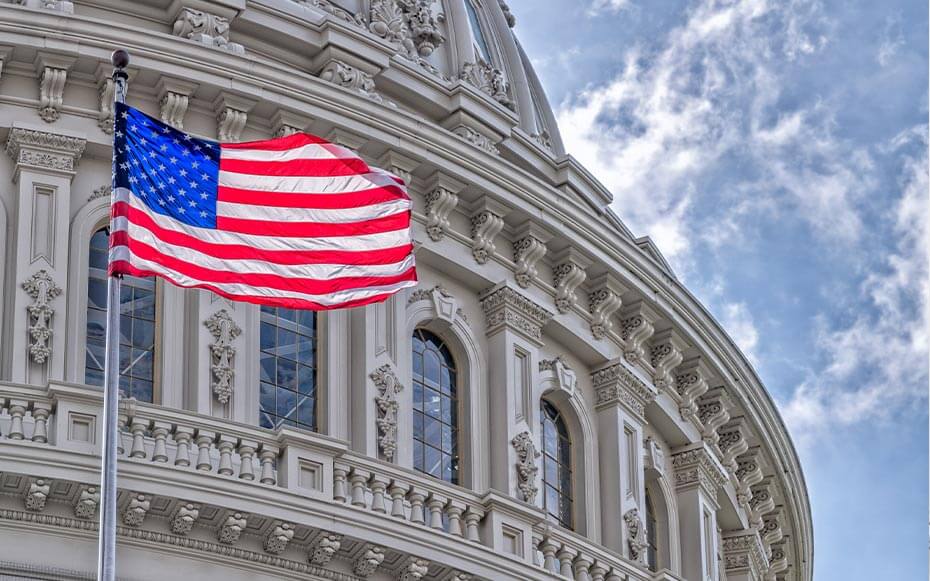Congress returns to Washington after wrapping up one of the most unpredictable and unproductive legislative sessions. From the 15-vote election of Speaker McCarthy to his dramatic ousting to the election of Speaker Johnson to an impeachment inquiry into President Biden, distractions in the House dominated Congress’ attention in 2023 resulting in the passage of only 27 bills through both chambers.
Since most must-pass legislation was pushed to early 2024, Congress returned to a very busy agenda. Almost immediately, they must deal with two critical funding deadlines set for January 19 and February 2. If they can’t reach an agreement, they must pass another Continuing Resolution (CR) or risk shutting down the government. Additionally, as part of the budget agreement negotiated last year to ensure the funding bills were passed on time, a 1% across-the-board sequester cut has been triggered and is set to go into effect in April.
Both sides have reportedly agreed to a topline spending level and can now begin negotiating allocations for each of the 12 appropriations bills. The agreement is said to be in line with the budget caps negotiated by former Speaker McCarthy as part of the debt ceiling agreement last year. Speaker Johnson told colleagues that the new agreement represents an actual year-over-year cut. In contrast, Majority Leader Schumer told Democrats that no additional cuts were made and that the number reached was aligned with their request.
Several members of the House Freedom Caucus have come out in opposition to the agreement, arguing that steeper cuts are needed. Speaker Johnson is now actively discussing reneging on the deal. Republicans can only afford to lose three GOP votes when they bring the funding bills to the floor, so they will need the support of Democrats. Adding another layer of complexity to the process is the policy riders. The GOP is pursuing proposed policy additions on abortion and diversity efforts, but Democrats have said that they are non-starters on their side.
With less than two weeks before the first deadline and none of the 12 bills passed, there is already discussion about the need for another CR and the length of that CR. Some Republicans have floated the idea of a year-long CR, which would result in a 10% across-the-board cut in nondefense spending. Others have suggested a bill that would fund the government through March. The bottom line is that a partial government shutdown will occur on January 20 if Congress doesn’t reach a deal or pass another CR. Congress is also continuing to negotiate over $100 billion in supplemental funding for Ukraine and Israel. A deal on immigration and border policies will need to be struck to move the legislation forward.
On the policy side, workforce development and higher education will continue to garner Congress’ attention in 2024. Discussions around the role diversity, equity, and inclusion should play in employer and higher education decision-making, the value of a college degree, and reducing/eliminating degree requirements for certain jobs will continue. House Education and the Workforce Committee Chairwoman Foxx has already announced plans to investigate several universities to better understand where their focus is, including how they are handling antisemitism and DEI. Congress will also pick up on last year’s efforts to advance legislation that would allow the use of Pell Grants for short-term training programs and increase investments in apprenticeship programs. Additionally, work will continue to advance two major reauthorizations impacting higher education and workforce development this year: the Workforce Innovation and Opportunity Act (WIOA) and the Higher Education Act (HEA).
Workforce
Several workforce changes are under discussion in the WIOA, including:
- Reforming eligibility criteria for providers of workforce training;
- Increasing accountability for training providers and state and local workforce boards;
- Expanding the use of training accounts for individuals;
- Adding digital literacy to the list of core competencies included in adult education programs;
- Tweaking how the system handles young workers; and
- Beefing up requirements on states to fund education programs in prisons.
Separately, there is bipartisan momentum to pass paid leave legislation in 2024. Congress is also considering an extension of tax credits for employers and an expansion of the child credit.
On the regulatory side, we expect the Department of Labor’s (DOL) delayed final overtime rule to come out in April. The DOL will also be updating Schedule A, a list of in-demand jobs for which employers pursuing work visas can sidestep certain procedural hurdles. The department is seeking to understand whether Schedule A is effective for addressing labor shortages in STEM fields and how to identify new STEM fields experiencing worker shortages.
Higher Education
Congress will continue to focus on higher education and reigning in bad actors. This will take many forms, from limiting funding to institutions to public testimony and investigations to the reexamination of long-established policies. Especially given that it is an election year, we can expect the politicization of and hostility toward higher education to grow.
Some of the areas we are expecting Congress to address include:
- Antisemitism;
- College costs/loan forgiveness;
- Campus free speech; and
- Student mental health.
The House plans to continue to pursue a piecemeal approach to reauthorizing the HEA, something that House Chairwoman Foxx has said is a priority for her this year. Additionally, given the rebound in international student enrollment post-COVID, we are likely to see calls for additional transparency and reporting, especially in higher-profile regions like the Middle East, Russia, and China.
On the regulatory side, the Department of Education (DOE) released its final rule on Gainful Employment last year. The rule is set to go into effect in July, but that timeline may change since the rule is currently being challenged in court.
The DOE continues reviewing comments around their proposed Title IX rules. The first rule overhauls how schools respond to sexual misconduct on campus. The second rule expands the meaning of sexual discrimination to include gender identity and prevents schools and colleges from banning transgender student sports participation. We expect both final rules to be released in March.
A series of issue briefs were also recently released by the DOE. The briefs outline 2024 plans to convene a committee to update regulations that:
- Change how the Department oversees accreditors:
- Revise rules around reciprocity agreements that states have reached to supervise out-of-state online programs;
- Open college prep programs to undocumented students; and
- Create more student-friendly policies on how colleges apply financial aid to student accounts.
Election Year
2024 is also a presidential election year. In addition to the president and vice president, all 435 seats in the House of Representatives and 34 of the 100 Senate seats will be up for election. Congress will be working on a compressed schedule to leave time for campaigning. The House is scheduled to be in session for 28 weeks and the Senate for 29. Both will be in recess for all of August and October.
The issues we expect to continue to dominate election discussions are:
- The cost of living;
- Abortion;
- Immigration;
- Freedom/democracy;
- Health care access;
- Medicare and social security; and
- Foreign policy.
In Congress, current speculation is that we could see both the House and Senate flip. If that happens it would be the first time that party control of congressional chambers changed in opposite directions in the same election. While nothing is set in stone, it is expected that our Democratic presidential candidate will be President Joe Biden and our Republican candidate will be former President Donald Trump. The elections will be held on Tuesday, November 5.






